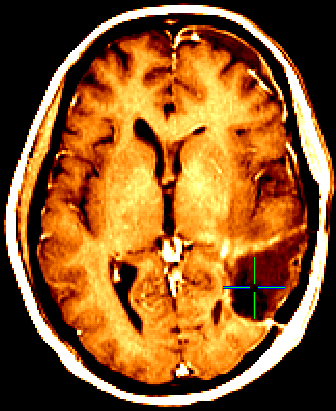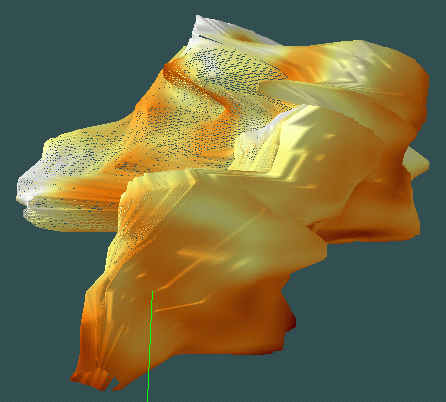Paul Thompson's Research Publications
Tracking and Modeling Tumor Growth Rates
in Patients with Malignant Gliomas
Annual Meeting of the American
Academy of Neurology, 2000 [submitted]
Haney S, Thompson PM, Cloughesy TF, Alger JR,
Toga AW
Laboratory of Neuro Imaging, Dept. Neurology, Division of Brain Mapping,
UCLA School of Medicine, Los Angeles CA 90095, USA,
UCLA Dept. of Radiological Sciences,
and
Neuro-Oncology Program, UCLA School of Medicine
|
ABSTRACT
|


Surface modeling approaches help to capture the complex morphology
of brain tumors. They can be used in conjunction with
tissue classification approaches to assess growth
rates and
therapeutic response, and are sufficently detailed to track subtle changes in
the dynamics of tumor growth.
|
Objective.
As part of a comprehensive study of patients with malignant gliomas, two image
analysis
algorithms were applied to serial MRI scans. Rates of change were tracked for
gadolinium-enhancing
tissue, peritumoral edema and cystic compartments. The purpose of this study
was to investigate the
accuracy of two 3-dimensional image analysis algorithms in tracking tissue
changes by comparing the
results to a manually segmented gold standard.
Background.
Methods currently employed to estimate tumor response to therapy are not reliable.
A method capable of accurately and systematically tracking changes in tumors
would be valuable in
patient management and in therapy evaluations, providing a quantitative index of comparison
for multicenter trials.
3D structural maps also provide a stereotaxic framework for the correlation of
data from other
modalities. Tumor changes were tracked with a reliable, objective tissue
classification algorithm
and with a surface modeling algorithm which has successfully been used to track
minute changes in the corpus
callosum in children.
Design/Methods.
3D T2-weighted and gadolinium-enhanced T1-weighted (256x256 resolution, 3
mm spacing) SPGR MRI volumes were acquired over a 3.5 year period from 10
patients with
histopathologically confirmed glioblastoma multiforme (GBM; age 4-54 yrs at
first
scan). Scans were
automatically aligned into Talairach stereotaxic space and one or both of the
following protocols were
applied: (1) Tissue Classification; tissue maps were created by determining a
Gaussian mixture
distribution reflecting the image intensities of specific tissue classes in the
scan series. A nearest
neighbor algorithm was used to differentiate tissue types and its accuracy
confirmed by tagging points.
Tissue maps were manually adjusted to better delineate class boundaries.
(2) Surface Modeling; tumor
enhancement volumes were traced and a 3D surface reconstruction algorithm based on
tiled, parametric
mesh modeling was applied. Results from the nearest neighbor and surface
modeling algorithms were
compared with manual segmentations.
Results.
T1-based segmentation maps, generated by the nearest neighbor algorithm, provided
excellent tissue differentiation and growth rate evaluation for tumor
enhancement (r-squared=0.99).
Volumetric changes in tumor components ranged from -73% to +2600%,
corresponding to a halving
time of 130 days and a doubling time of 13.8 days. Volumetric measurements of
edema were
systematically 16.5%+/-8.8% lower in T1-based maps (average volume
70.5+/-55.9cm3) than
T2-based maps (average volume 82.5+/-63.3 cm3; p<0.001, paired
t-test) but
values were highly
correlated as were volumes from surface modeling and the manually derived gold
standard
(r-squared=0.94).
Conclusions.
Tissue maps, based on the nearest neighbor algorithm, provide significant power in
tracking the regional dynamics of multiple tissue classes in GBM patients. The
resulting
tissue-classification and growth rate detection systems also provide a 3D
structural framework to
correlate spectroscopic, diffusion and histopathologic indices in
interventional studies and
quantitatively evaluate therapeutic response in individual patients or
clinically-defined groups.
Grant Support: (to P.T. and A.W.T.): NIMH/NIDA (P20 MH/DA52176),
P41 NCRR (RR13642); (A.W.T.): NLM (LM/MH05639), NSF
(BIR 93-22434), NCRR (RR05956) and NINCDS/NIMH (NS38753).
Related Publications
(back to main list)
Contact Information
Mail:
Paul Thompson, Ph.D.
Assistant Professor of Neurology
UCLA Lab of Neuro-Imaging and Brain Mapping Division
Dept. Neurology and Brain Research Institute
4238 Reed Neurology, UCLA Medical Center
710 Westwood Plaza
Westwood, Los Angeles CA 90095-1769, USA.
E-mail:
thompson@loni.ucla.edu
Tel: (310)206-2101
Fax: (310)206-5518

